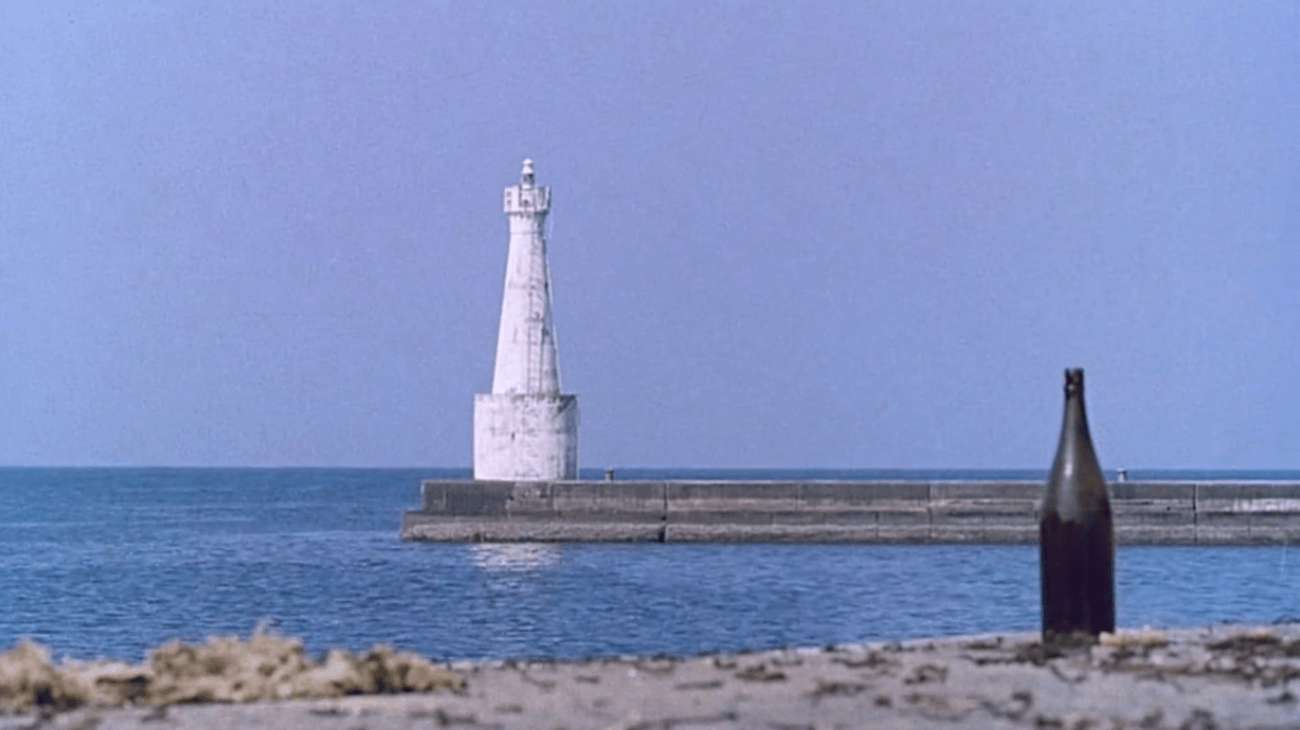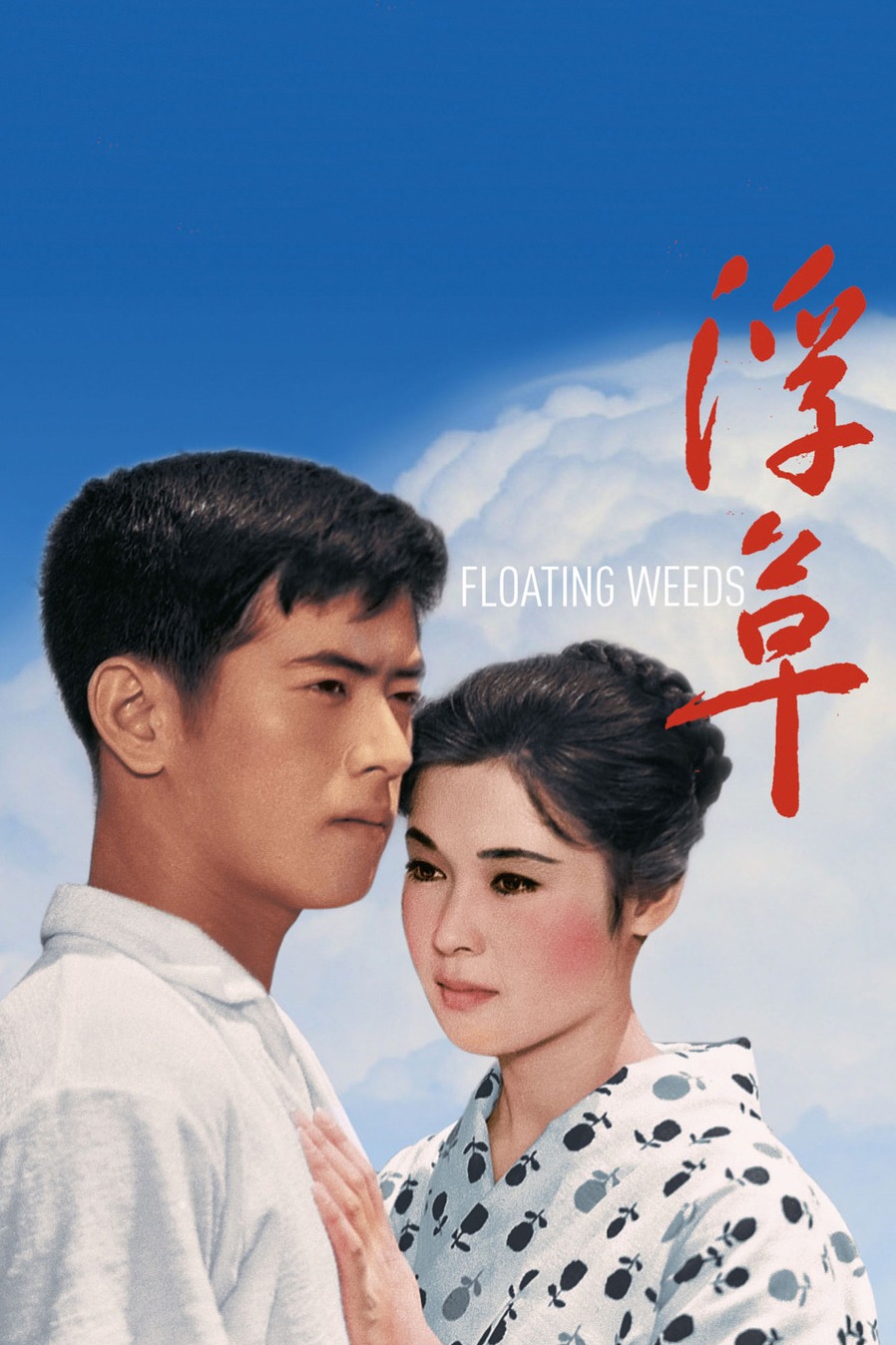
Show people
A review requested by a contributor who wishes to remain anonymous, with thanks for donating to the Second Quinquennial Antagony & Ecstasy ACS Fundraiser.
The first time I sat down to watch Ozu Yasujiro's 1959 Floating Weeds (this would have been in 2005), I couldn't get past the second shot (not including the opening credits, white and red text against a yellowing burlap background). Not because the first shots are bad! In fact, it was because they were so very, very good.
The first shot isn't a particularly complicated thing: the bright blue sky fills up the top three-quarters of the frame, the blue sea most of the bottom quarter, save for a diagonal slice of asphalt across the very bottom, describing the road overlooking the water. A concrete pier just barely below the level of the water extends three-fifths of the way from right to left. A white lighthouse rises from the end of it. Most of the way to the right, a black bottle stands on the road, mirroring the exact shape of the lighthouse (the bottle is just a little bit smaller). Just a nice little bit of echoing: the light blue echoed by the dark blue, the tower echoed by the bottle. The perfection of the horizontal lines is shockingly interrupted by the diagonal of the land. It's a simple, largely empty composition, and the moment I saw it, I was aware that it was the best opening shot in cinema. I was not ready for that, and when the second shot came along, I was almost hyperventilating at the perfection of it.
Here, for the record, is that opening shot:

And here are the three shots that follow it:



Laugh if you must, dear reader, but the profound effect that first shot had on me was more than I could bear: the minimalist perfection, the exactness of the composition was overwhelming, the shattering beauty of such a small number of lines and colors left me almost quivering. And then along came that second shot, with the lighthouse shrinking in the frame and shifting position to force the slightest flicker of the eyes over to the right, just enough that you become extremely aware of the fact that your eye just moved, and in that movement catch the full weight of the composition and realise even before you've taken the time to look at all of it how balanced it is - not symmetrical, but balanced, and perfectly anchored by the lighthouse in a very different way than it anchors the first shot.
The opening four shots of Floating Weeds, which I still think today as I knew in 2005 is the finest opening sequence in the history of film, are extraordinarily pleasurable in their own right, but they're also a promise, a challenge, even a threat. "This is how the movie will progress", they state, "this extremely fine-grained manipulation and contrast of compositions, and if you intend to get the most out of Floating Weeds, you'll need to be ready to examine and absorb the totality of each flawless composition in combination with the equally total, flawless compositions before and after it." I couldn't do it - in that moment, I didn't have the energy and attention span to do that. So I bailed out of the film (which was not, anyway, my first exposure to Ozu, so I well knew what an intense viewing experience was in line regardless), and now, 12 years later, I have finally seen it.
The good news: Floating Weeds lives up to those four opening shots. I'm not convinced that it's the most perfect of Ozu's six films in color, but "most perfect" is of course a semantically nonsensical phrase. And even if An Autumn Afternoon, the director's 1962 swan song, is at least arguably a finer achievement, this leaves us with Floating Weeds being at least somewhat perfect. It's a unique film in the director's late period for a handful of reasons, the most banal and objective of which is that it's the solitary film he directed for Daiei Film. His contract with his home studio, Shochiku, required him to produce one feature per year, and given the slowness and focus of his work, that used up all the time he had. In 1959, however, he managed to complete Good Morning for Daiei early, and this freed him up to take on that studio's eager offer for him to make a movie there. This meant, first, that Floating Weeds was somewhat naturally inclined to be a more upbeat movie than most of Ozu's output (Shochiku released many melodramas, but Daiei favored cheerier fare), in tone if not in plot. Second, it put Ozu in contact with the great cinematographer Miyagawa Kazuo, a Daiei contractor responsible for shooting such visual masterpieces as Kurosawa's Rashomon and Mizoguchi's Sansho the Bailiff. It would be meaningless to try to apply a phrase like "the best-looking film" to a career in which the perfect precision of imagery was such an overriding priority as it had been for Ozu, so I won't call Floating Weeds the best-looking Ozu film. But I want you to know that I thought about it really hard.
The other point of distinction is that Floating Weeds is a direct remake of one of Ozu's earlier successes, the 1934 silent film A Story of Floating Weeds. And here we do not to be cagey; much of Ozu's output can be rightfully described as a "remake" of his earlier work: any film whose Japanese title includes a reference to the seasons is part of an overarching study of parent-child relationships at various pressure points, Good Morning is a redo of I Was Born, But... in all but name, and so forth. Still, the relationship between the two Floating Weedses is unusually precise and direct (I'm unfamiliar with the 1928 American film The Barker that provided the basis for both). They tell virtually identical stories about the family tragedy that journeys into a small town with a crummy, low-rent kabuki troupe. In 1957 or '58 - offhand reference to World War II as a living, but now comfortably slumbering memory abound - that troupe is led by Komajuro (Nakamura Ganjiro, giving a sterling, sensitive, but flinty performance - he only worked one other time with Ozu, in 1961's The End of Summer, which seems a horribly missed opportunity to me), an actor prone to overplaying things, currently having an affair with his substantially younger leading lady Sumiko (Kyo Machiko). The small town they've just arrived at by boat has particular importance for Komajuro: many years ago, he had a relationship with local restraurant owner Oyoshi (Sugimura Haruko, the only Ozu regular with a lead role), and fathered her son. Now grown almost to adulthood, the boy Kiyoshi (Kawaguchi Hirsoshi) thinks of Komajuro as his uncle, who arrives only at rare intervals to lavish a decidedly more-than-avuncular level of attention on the young man. Komajuro has taken great pains to hide this information from his troupe, but he's indiscreet this time around, and in a jealous fit, Sumiko tries to hurt him, in a relatively passive way, paying the troupe's ingenue Kayo (Wakao Ayako) to seduce the boy.
In the 1934 film, this was all played as brutal tragedy, accentuated by the hard blacks of the dark cinematography. That film came right at the start of Ozu's maturity as an artist, and by the time we arrive at the remake, he had evolved into a thoughtful 50-something, whose attitude to humanity had grown mellower and mellower. By the time of his final period - the six films he made in color at the end of his career, beginning with Equinox Flower in 1958 - he had abandoned the moral judgment that animated A Story of Floating Weeds and continued even in muted form in something as patient and forgiving as Tokyo Story in 1953. When we arrive at Floating Weeds, we find a film that therefore lacks all of the cruel edges of Story of Floating Weeds, and has a literally much sunnier tone to it. People still suffer for the choices they and others make, but there's no longer a tinge of cosmic injustice to it; Ozu and co-writer Noda Kogo seem to regard the characters' actions as merely what happened, calmly and respectfully allowing their characters to feel tormented, but equally respectfully allowing them to feel resolved and comfortable, as needed. The addition of some thirty minutes is used almost entirely to let the plot sink in, and to give the side characters more of a chance to have personalities, but not to add plot. The end of A Story of Floating Weeds is heartbreaking; the end of Floating Weeds is at most rueful, and maybe not even that. Maybe it's just tenderly, pragmatically aware that not everything works out. At any rate, the film ends with a shot almost as perfect as the four that open it: a train, chugging away into the dark blue night, a black silhouette with perfect round, red taillights diminishing over a hill.
Red matters a hell of a lot in Floating Weeds; you can see it if you look back up at the fourth shot of the opening. It feels, almost, like the film is made of just two colors: red, and everything else but red. And red is used sparingly, as a grace note, an accent mark, a dash of seasoning. I don't think it means anything: its importance is solely internal, so that every time red appears, we notice the appearance of red. Much like the lighthouse, which is used occasionally throughout the film as a grounding element in the composition, to bring our heads and eyes "back to center", if you will (come to think of it, bottles do much the same thing), the color red is used to unify the movie, to keep us aware that redness binds the action and contains it. Red is why Floating Weeds is a self-contained object, rather than a series of random scenes about the members of a touring kabuki troupe.
And even if it were that random thing - so what? By this point, characters are the primary, even exclusive focus of Ozu's cinema. Not what happens to them, but simply who they are. It's the primary aesthetic motivation for his famously uniform aesthetic (once you've seen any post-war Ozu film, you've seen all of them, as far as cutting patterns and camera angles go; color adds a lot, but that basically means there's only one variable between no fewer than 15 films. This isn't meant to be dismissive: Ozu's films in this period collectively represent maybe my favorite achievement in all of sound cinema), which discards standard rules of cutting and establishing space to do one of two things: present a character facing almost straight towards us, to give us a chance to look in their eyes and understand who they are and what they think; or place humans as objects to be posed in geometrical shapes, and thereby to give us an inkling of the social and interpersonal responsibility that weighs down on them. By the end, all that matters in an Ozu film is who we're watching, and how we come to know them over the course of the movie, sometimes in surprising revelations, sometimes in a series of actions that confirm what we already suppose about them. With its sunshiny world holding a man who doesn't want to admit that he's been pretty shitty at being a father, and the individuals who respond to his behavior as a result of that shame, Floating Weeds is as good an expression of the Ozu ideal as any other film, and while in some cases it's atypical of his greatest work - I prefer his movies that focus on long-established family relationships, rather than the pain of trying to enforce dormant relationships, as we see here - it's hard to regard it as anything but an exemplar of a career and an aesthetic universe that's extraordinary even in much weaker films than this one.
The first time I sat down to watch Ozu Yasujiro's 1959 Floating Weeds (this would have been in 2005), I couldn't get past the second shot (not including the opening credits, white and red text against a yellowing burlap background). Not because the first shots are bad! In fact, it was because they were so very, very good.
The first shot isn't a particularly complicated thing: the bright blue sky fills up the top three-quarters of the frame, the blue sea most of the bottom quarter, save for a diagonal slice of asphalt across the very bottom, describing the road overlooking the water. A concrete pier just barely below the level of the water extends three-fifths of the way from right to left. A white lighthouse rises from the end of it. Most of the way to the right, a black bottle stands on the road, mirroring the exact shape of the lighthouse (the bottle is just a little bit smaller). Just a nice little bit of echoing: the light blue echoed by the dark blue, the tower echoed by the bottle. The perfection of the horizontal lines is shockingly interrupted by the diagonal of the land. It's a simple, largely empty composition, and the moment I saw it, I was aware that it was the best opening shot in cinema. I was not ready for that, and when the second shot came along, I was almost hyperventilating at the perfection of it.
Here, for the record, is that opening shot:
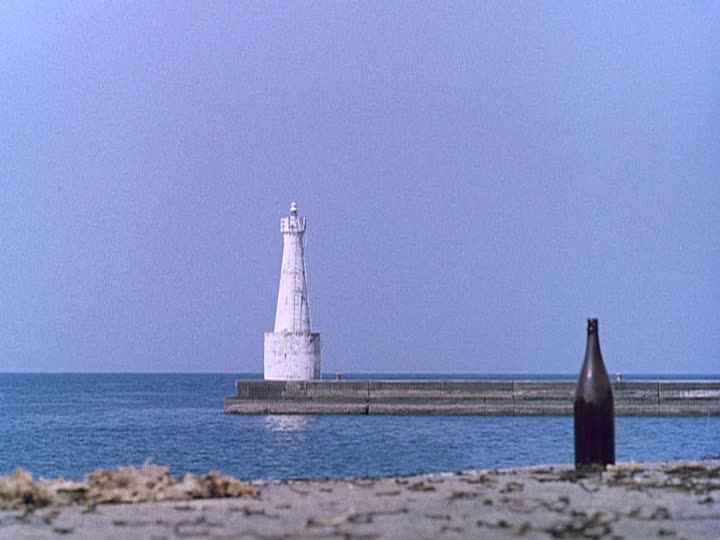
And here are the three shots that follow it:
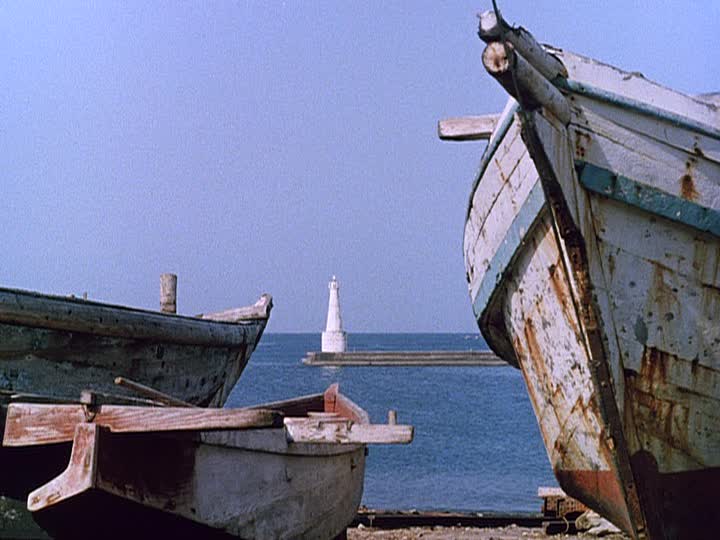
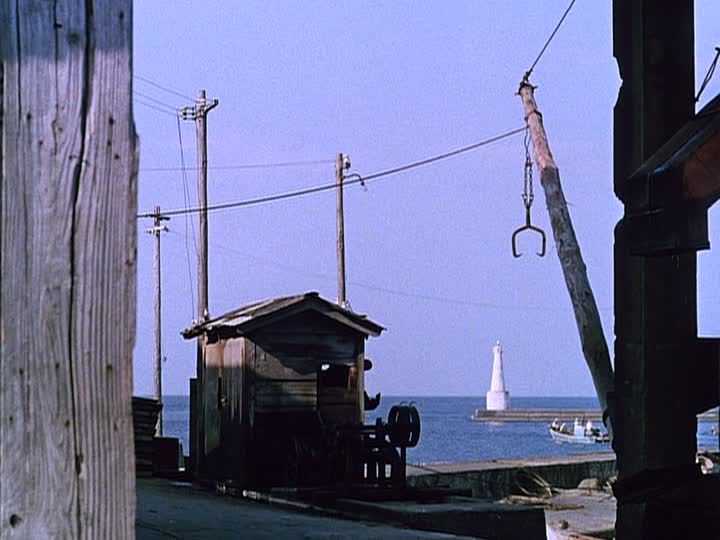
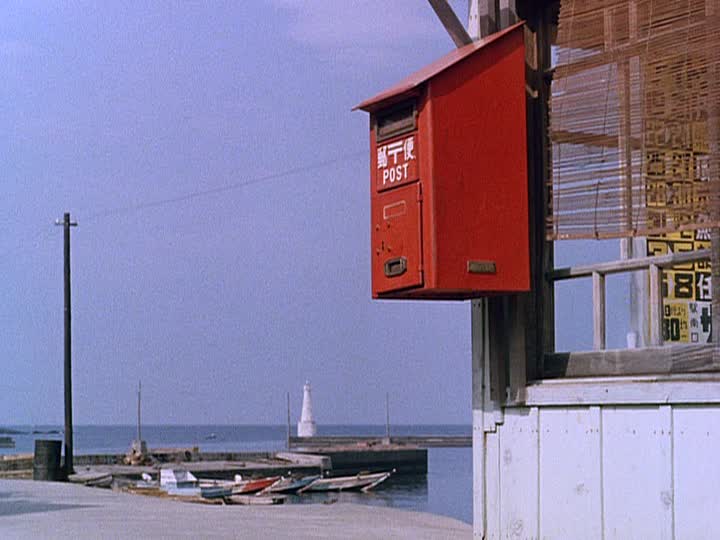
Laugh if you must, dear reader, but the profound effect that first shot had on me was more than I could bear: the minimalist perfection, the exactness of the composition was overwhelming, the shattering beauty of such a small number of lines and colors left me almost quivering. And then along came that second shot, with the lighthouse shrinking in the frame and shifting position to force the slightest flicker of the eyes over to the right, just enough that you become extremely aware of the fact that your eye just moved, and in that movement catch the full weight of the composition and realise even before you've taken the time to look at all of it how balanced it is - not symmetrical, but balanced, and perfectly anchored by the lighthouse in a very different way than it anchors the first shot.
The opening four shots of Floating Weeds, which I still think today as I knew in 2005 is the finest opening sequence in the history of film, are extraordinarily pleasurable in their own right, but they're also a promise, a challenge, even a threat. "This is how the movie will progress", they state, "this extremely fine-grained manipulation and contrast of compositions, and if you intend to get the most out of Floating Weeds, you'll need to be ready to examine and absorb the totality of each flawless composition in combination with the equally total, flawless compositions before and after it." I couldn't do it - in that moment, I didn't have the energy and attention span to do that. So I bailed out of the film (which was not, anyway, my first exposure to Ozu, so I well knew what an intense viewing experience was in line regardless), and now, 12 years later, I have finally seen it.
The good news: Floating Weeds lives up to those four opening shots. I'm not convinced that it's the most perfect of Ozu's six films in color, but "most perfect" is of course a semantically nonsensical phrase. And even if An Autumn Afternoon, the director's 1962 swan song, is at least arguably a finer achievement, this leaves us with Floating Weeds being at least somewhat perfect. It's a unique film in the director's late period for a handful of reasons, the most banal and objective of which is that it's the solitary film he directed for Daiei Film. His contract with his home studio, Shochiku, required him to produce one feature per year, and given the slowness and focus of his work, that used up all the time he had. In 1959, however, he managed to complete Good Morning for Daiei early, and this freed him up to take on that studio's eager offer for him to make a movie there. This meant, first, that Floating Weeds was somewhat naturally inclined to be a more upbeat movie than most of Ozu's output (Shochiku released many melodramas, but Daiei favored cheerier fare), in tone if not in plot. Second, it put Ozu in contact with the great cinematographer Miyagawa Kazuo, a Daiei contractor responsible for shooting such visual masterpieces as Kurosawa's Rashomon and Mizoguchi's Sansho the Bailiff. It would be meaningless to try to apply a phrase like "the best-looking film" to a career in which the perfect precision of imagery was such an overriding priority as it had been for Ozu, so I won't call Floating Weeds the best-looking Ozu film. But I want you to know that I thought about it really hard.
The other point of distinction is that Floating Weeds is a direct remake of one of Ozu's earlier successes, the 1934 silent film A Story of Floating Weeds. And here we do not to be cagey; much of Ozu's output can be rightfully described as a "remake" of his earlier work: any film whose Japanese title includes a reference to the seasons is part of an overarching study of parent-child relationships at various pressure points, Good Morning is a redo of I Was Born, But... in all but name, and so forth. Still, the relationship between the two Floating Weedses is unusually precise and direct (I'm unfamiliar with the 1928 American film The Barker that provided the basis for both). They tell virtually identical stories about the family tragedy that journeys into a small town with a crummy, low-rent kabuki troupe. In 1957 or '58 - offhand reference to World War II as a living, but now comfortably slumbering memory abound - that troupe is led by Komajuro (Nakamura Ganjiro, giving a sterling, sensitive, but flinty performance - he only worked one other time with Ozu, in 1961's The End of Summer, which seems a horribly missed opportunity to me), an actor prone to overplaying things, currently having an affair with his substantially younger leading lady Sumiko (Kyo Machiko). The small town they've just arrived at by boat has particular importance for Komajuro: many years ago, he had a relationship with local restraurant owner Oyoshi (Sugimura Haruko, the only Ozu regular with a lead role), and fathered her son. Now grown almost to adulthood, the boy Kiyoshi (Kawaguchi Hirsoshi) thinks of Komajuro as his uncle, who arrives only at rare intervals to lavish a decidedly more-than-avuncular level of attention on the young man. Komajuro has taken great pains to hide this information from his troupe, but he's indiscreet this time around, and in a jealous fit, Sumiko tries to hurt him, in a relatively passive way, paying the troupe's ingenue Kayo (Wakao Ayako) to seduce the boy.
In the 1934 film, this was all played as brutal tragedy, accentuated by the hard blacks of the dark cinematography. That film came right at the start of Ozu's maturity as an artist, and by the time we arrive at the remake, he had evolved into a thoughtful 50-something, whose attitude to humanity had grown mellower and mellower. By the time of his final period - the six films he made in color at the end of his career, beginning with Equinox Flower in 1958 - he had abandoned the moral judgment that animated A Story of Floating Weeds and continued even in muted form in something as patient and forgiving as Tokyo Story in 1953. When we arrive at Floating Weeds, we find a film that therefore lacks all of the cruel edges of Story of Floating Weeds, and has a literally much sunnier tone to it. People still suffer for the choices they and others make, but there's no longer a tinge of cosmic injustice to it; Ozu and co-writer Noda Kogo seem to regard the characters' actions as merely what happened, calmly and respectfully allowing their characters to feel tormented, but equally respectfully allowing them to feel resolved and comfortable, as needed. The addition of some thirty minutes is used almost entirely to let the plot sink in, and to give the side characters more of a chance to have personalities, but not to add plot. The end of A Story of Floating Weeds is heartbreaking; the end of Floating Weeds is at most rueful, and maybe not even that. Maybe it's just tenderly, pragmatically aware that not everything works out. At any rate, the film ends with a shot almost as perfect as the four that open it: a train, chugging away into the dark blue night, a black silhouette with perfect round, red taillights diminishing over a hill.
Red matters a hell of a lot in Floating Weeds; you can see it if you look back up at the fourth shot of the opening. It feels, almost, like the film is made of just two colors: red, and everything else but red. And red is used sparingly, as a grace note, an accent mark, a dash of seasoning. I don't think it means anything: its importance is solely internal, so that every time red appears, we notice the appearance of red. Much like the lighthouse, which is used occasionally throughout the film as a grounding element in the composition, to bring our heads and eyes "back to center", if you will (come to think of it, bottles do much the same thing), the color red is used to unify the movie, to keep us aware that redness binds the action and contains it. Red is why Floating Weeds is a self-contained object, rather than a series of random scenes about the members of a touring kabuki troupe.
And even if it were that random thing - so what? By this point, characters are the primary, even exclusive focus of Ozu's cinema. Not what happens to them, but simply who they are. It's the primary aesthetic motivation for his famously uniform aesthetic (once you've seen any post-war Ozu film, you've seen all of them, as far as cutting patterns and camera angles go; color adds a lot, but that basically means there's only one variable between no fewer than 15 films. This isn't meant to be dismissive: Ozu's films in this period collectively represent maybe my favorite achievement in all of sound cinema), which discards standard rules of cutting and establishing space to do one of two things: present a character facing almost straight towards us, to give us a chance to look in their eyes and understand who they are and what they think; or place humans as objects to be posed in geometrical shapes, and thereby to give us an inkling of the social and interpersonal responsibility that weighs down on them. By the end, all that matters in an Ozu film is who we're watching, and how we come to know them over the course of the movie, sometimes in surprising revelations, sometimes in a series of actions that confirm what we already suppose about them. With its sunshiny world holding a man who doesn't want to admit that he's been pretty shitty at being a father, and the individuals who respond to his behavior as a result of that shame, Floating Weeds is as good an expression of the Ozu ideal as any other film, and while in some cases it's atypical of his greatest work - I prefer his movies that focus on long-established family relationships, rather than the pain of trying to enforce dormant relationships, as we see here - it's hard to regard it as anything but an exemplar of a career and an aesthetic universe that's extraordinary even in much weaker films than this one.

